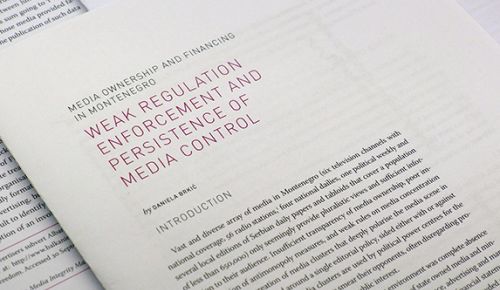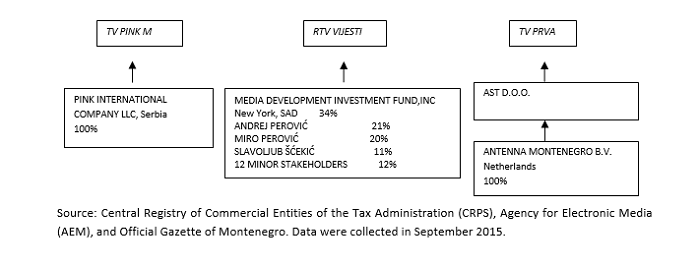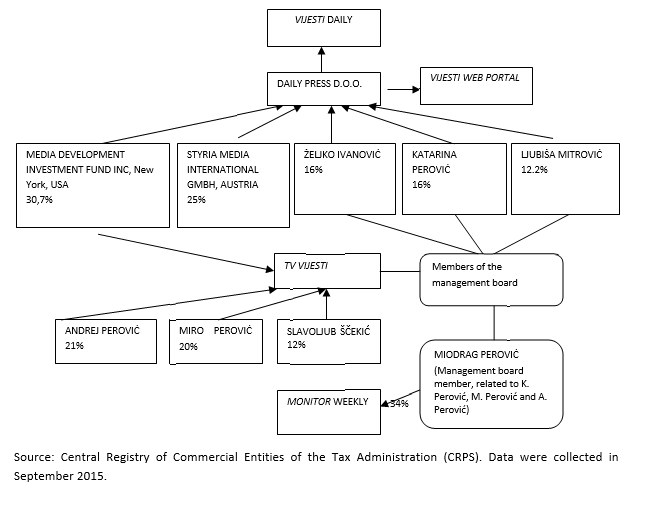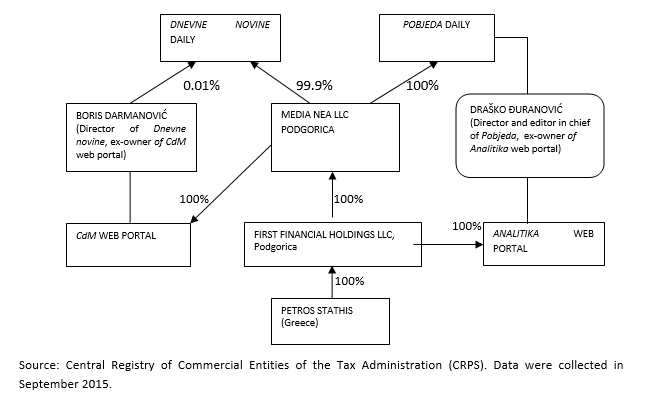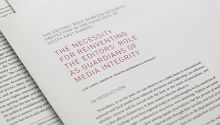Weak regulation enforcement and persistence of media control
INTRODUCTION
Vast and diverse array of media in Montenegro (six television channels with national coverage, 56 radio stations,1 four national dailies, one political weekly and several local editions of Serbian daily papers and tabloids that cover a population of less than 650,000) only seemingly provide pluralistic views and sufficient information to their audience. Insufficient transparency of media ownership, poor implementation of antimonopoly measures, and weak rules on media concentration have led to the creation of media clusters that deeply polarise the media scene in the country. Organised around a single editorial policy, sided either with or against the ruling regime, such media clusters are used by political power centres for the propagation of their agendas and to smear their opponents, often disregarding professional standards and neglecting the public interest.
Insufficient transparency of media ownership, poor implementation of antimonopoly measures, and weak rules on media concentration have led to the creation of media clusters that deeply polarise the media scene in the country.
What contributed to the creation of such an environment was complete absence of the rules on state advertising, delayed privatisation of state owned media and minimum interference of regulatory bodies in the areas of finance, advertising and market competition. In 2014, the tax administration revealed the financial statements of media companies for the first time. They showed that in an overcrowded market only a handful of outlets are able to sustain their operation. With no direct business interest, foreign media acquisitions are, judging by their pro-government editorial policies, another leverage of public pressure to the regime’s opponents. Those businesses are supported either by the help of the state, or through several advertising companies with political and business ties that control a major part of the advertising revenues in the market. In such a trade off, where favourable editorial content is paid by business or political interest, the integrity of media is sacrificed. The media are becoming an arena for inflammatory journalism, with even the traditional media falling victim to the growing trend of media tabloidisation.
Although the international media watchdog organisations are warning of the deteriorating state of media freedom in Montenegro,2 little effort has been made to improve the situation. Without better regulation and stronger enforcement of fair competition rules, the situation is not likely to change.
In such a trade off, where favourable editorial content is paid by business or political interest, the integrity of media is sacrificed.
1 MEDIA OWNERSHIP
Privatisation of state owned media was completed only in November 2014, with more than a decade of delay. During that time the state, at considerable costs for tax payers, preserved its control over the daily Pobjeda and used it for promotion of its political agenda. The new owners, however, has provided continuance of the same editorial policy.
The ownership patterns in the media in Montenegro shifted from donor-supported, locally started outlets during the process of democratisation of media in the late 1990s (which often operated under the prefix of “independent”) to a more interest-driven media business, run by foreign capital. In 2015, two out of the four national televisions are owned by foreign companies, and only one out of four dailies has local owners.
1.1 REGULATION OF MEDIA OWNERSHIP
Ground rules for media ownership are set in the Media Law3 (2002). Its primary task was to regulate the transfer of state owned media to their new private owners. However, the envisaged timeframe for the transformation of state owned media set for 31 December 2004 was not complied with for another decade.
To prevent the creation of monopolies, the Electronic Media Law4 (2010) makes it illegal for a broadcaster with national coverage to hold more than 25 percent stake in another national broadcaster or more than 10 percent stake in a news agency or daily print media with the circulation exceeding 3,000 copies (Article 131). The regulatory body, Agency for Electronic Media, has on several occasions successfully intervened in cases of illegal media concentration.
However, since the scope of this law was focused primarily on electronic media, the provision that would limit simultaneous ownership over two or more print media has never been introduced in legislation. Such a case, eventually, surfaced in late 2014, when the same company became the owner of two daily papers.
1.2 MEDIA MARKET
1.2.1 TELEVISION
Montenegro has six national televisions including two channels of public service broadcasting TVCG1 and TVCG2. The size of the Montenegrin media market has always been a limiting factor to media ventures, especially in TV business where production costs could hardly be covered by marketing revenues. Many locally started media in the era of democratisation in the late 1990s and 2000s (TV Montena, TV Elmag, TV IN) went bankrupt, while those which survived have turned to foreign investors. Simultaneously with the downfall of locally owned media, the regional media owners, mostly from Serbia, found fertile ground in the Montenegrin media market. With no language barriers, those media offered programs produced in Serbia, with minimum cost of local production. The audience, however, lost the considerable amount of locally relevant content.
Both TV Pink M and TV Prva entered the market as affiliates of Serbian channels, belonging to larger regional media groups – Pink Media Group, owned by Serbian media entrepreneur Željko Mitrović and Antenna Group, a media corporation founded by the Greek capital. The owners of the latter are not known to the Montenegrin public. The television operates under the company Antenna Montenegro BV, located in Amsterdam and managed by foreign individuals. According to data of the Netherlands company register,5 Antenna Montenegro BV is a granddaughter company of Antenna Group BV, registered as a financial holding, with 18 connected companies.
Both television channels rapidly gained audience share and kept their leadership position mostly by broadcasting soap operas from Latin America, India and Turkey, reality and talent shows, with local production mainly limited to news programs with pro-government oriented editorial policies and low level of audience trust.6
Regional media owners, mostly from Serbia, found fertile ground in the Montenegrin media market. With no language barriers, those media offered programs produced in Serbia, with minimum cost of local production. The audience, however, lost the considerable amount of locally relevant content.
On the other hand TV Vijesti emerged as an expansion of the eponymous major national print media, with the support of the US based Media Development Investment Fund. Due to the rules on media ownership concentration in the Electronic Media Law, the original founders, Željko Ivanović, Katarina Perović, Miodrag Perović and Ljubiša Mitrović transferred their shares (around 6 percent each) to the existing minor owners, Miro Perović and Slavoljub Šćekić, and to a new one – Andrej Perović, while keeping their managerial positions. The impact of TV Vijesti has been significant. In just two years as of its foundation (2008), the channel gained 14 percent of the audience share, all while promoting quality news programmes with elements of investigative journalism with a strong critical attitude toward the ruling regime.
Chart 1: OWNERSHIP STRUCTURE OF TOP THREE TV CHANNELS
Competition between the three channels has not produced more quality content to the benefit of the public, nor can this competition be considered fair. While the locally owned TV channels invested considerable resources to produce contents more relevant to the viewers (see Table 1), foreign owned televisions took on considerable audiences and, consequently, a considerable marketing share in the reality entertainment shows and soap operas with little or no costs of local production.
Table 1: PERCENTAGE OF OWN PRODUCTION IN THE PROGRAMMES OF TV CHANNELS
For that reason, at the beginning of 2012, a regulation was adopted which obliged broadcast media to air a minimum of 10 percent of their own production.7 It is not known, however, whether this rule has ever been implemented. The latest available regulator’s monitoring report on the broadcasters’ local production quotas is from May 2012.8 The absence of the regulator’s control in this segment raises doubts of clientelistic treatment of the media with pro-government oriented editorial policies. Thus, for example, TV Pink M introduced in 2013 short news format “Minut-dva”, broadcasted on hourly intervals, which promote the government’s agenda, and, more often, smear the ruling regime opponents. One of the main focus points of this news programme is the alleged wrongdoing of their rivals – Vijesti.
The absence of the regulator’s control in this segment raises doubts of clientelistic treatment of the media with pro-government oriented editorial policies.
1.2.2 PRINT MEDIA MARKET
Editorial polarisation of the print media in the country to government supporters and opponents follows a similar ownership pattern as in the television market. The most influential media are those held by prominent local individuals, whose oppositional editorial policies are rivalled by foreign owned media companies close to the government.
The two most influential dailies in the country, Vijesti and Dan, both changed owners and editorial policies, but they continued to dominate the market for more than a decade. Founded in the late 1990s as rival voices of the then split Montenegrin ruling regime, one to support the idea of state independence, the other to promote the politics of Slobodan Milošević’s regime in Belgrade, today, they have become united in their critical attitude to the current ruling regime of Milo Đukanović.
While Vijesti’s founders (Miodrag Perović, Ljubiša Mitrović, Slavoljub Šćekić, and Željko Ivanović) remained constantly present in the ownership structure of the publishing company Daily Press, the co-investors changed from the German media group Westdeutsche Allgemeine Zeitung (WAZ), which held 50 percent stake in the company during 2003-2007, to the Media Development Investment Fund based in the United States which bought 25 percent share in 2008, and the Austrian Styria Medien AG which became the owner of another 25 percent of the corporate share of the Daily Press in 2009.
Chart 2: OWNERSHIP STRUCTURE OF DAILY PRESS COMPANY*
Dan, on the other hand, never searched for investors. Its publishing company Jumedia Mont, founded with a capital of dubious origin during the Slobodan Milošević’s dictatorship9 remained in possession of two individuals and their families – Mladen Milutinović and Duško Jovanović. Jovanović, who acted also as editor-in-chief of Dan, was murdered in a drive-by shooting at the front door of the paper’s offices on 28 May 2004. The case has not been fully resolved until today. Jovanović’s stake at the company now belongs to his wife and son.
Chart 3 OWNERSHIP STRUCTURE OF JUMEDIA MONT COMPANY
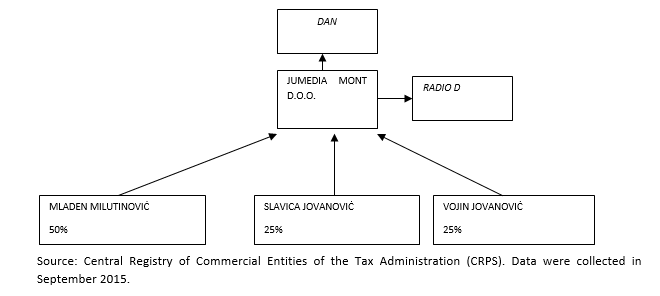
Competition to Vijesti and Dan started to build up in 2011 with the entrance of Greek capital in the media market. What started as a "completely independent business project" of start-up company Media Nea – daily Dnevne novine,10 turned out to be the beginning of major investment of a foreign businessman already present in Montenegro. While the sole reported founder of Media Nea was Boris Darmanović, the media, however, speculated that the real investor in this media venture was a Greek businessman Viktor Restis, tenant of the Montenegrin luxury resort Sveti Stefan.11 Although Darmanović refuted these reports, as of 2013, the Central registry of commercial court reports showed that the company First financial holdings, owned by Greek businessman Petros Stathis, a partner of Restis in Sveti Stefan resort, became the owner of 99,9 percent of the company. Two years later the same company bought the bankrupt state owned daily Pobjeda, turning both of these media into the greatest supporters of the government's agenda.
Chart 4: OWNERSHIP STRUCTURE OF DAILIES DNEVNE NOVINE AND POBJEDA
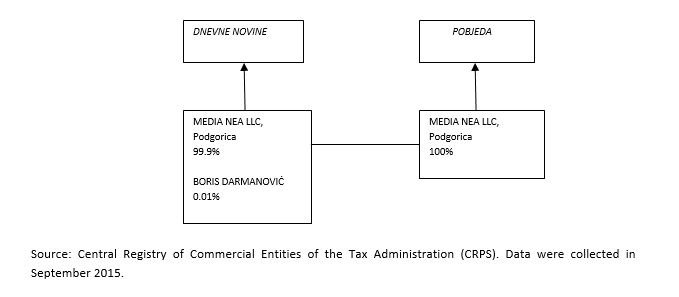
In addition to the four Montenegrin daily papers, there are Montenegrin editions of three dailies from Serbia (Blic, Večernje novosti and tabloid Informer).
1.2.3 ONLINE NEWS MEDIA
The youngest media market – that of online media – has been booming rapidly over the past years. Its raising popularity, besides the speed and availability of information, has come with mainly unedited free-to-post user-generated-content sections. Anonymous comments, it turned out, opened the doors to foul language and even hate speech which further deteriorated overall media discourse in the country.
The online media market itself is vastly non-regulated, so there are no specific ownership rules.
The ownership of main online news media is connected with traditional, print media, providing them with a new interactive niche for attracting more audience. Thus, the web portal
Vijesti operates within the same company as the daily Vijesti,
CafédelMontenegro (CdM) was founded and managed by Boris Darmanović, and
Analitika was founded and managed by Draško Đuranović. Later on
CdM was bought by Media Nea and
Analitika by First financial holdings, the company that owns Media Nea and the publisher of dailies
Dnevne novine and
Pobjeda. Darmanović and Đuranović became directors of
Dnevne novine and
Pobjeda respectively.
The online media market itself is vastly non-regulated, so there are no specific ownership rules. They are mentioned in the Electronic Media Law (2010) as “electronic publications.” The law defines them as “editorially formatted web pages” and/or “portals that contain electronic versions of print media” and/or “information from the media in a way that they are available to the general public regardless of their range”. The Agency for Electronic Media, however, admits that this is not enough even to define the scope of their jurisdiction, since the legal definition, as it is now, may as well refer to a Facebook page or a personal blog.12 The agency has recently started drafting by-laws that are expected to bring more order in this area.
1.3 ADVERTISING AGENCIES AND MEDIA BUYING AGENCIES
The media buying market in Montenegro is completely dominated by foreign agencies, mainly affiliates of Serbian companies.
Chart 5: OWNERSHIP STRUCTURE OF TOP THREE MEDIA BUYING AGENCIES

Media which choose their loyalties in favour of business opportunities are ready to put the ethical rules behind, thus providing the content that serves not the interest of public but political agendas.
Their accounts include major international advertisers which found it easier to do business through the agencies that sell media space across the region, especially considering the size of the Montenegrin market and no language barriers. This however puts the Serbian owned media in Montenegro in a favourable position, considering the existing business connections in their domicile market, where advertising services are often agreed in one, larger centre. Such ownership structures pose additional argument to the previous observation on potential clientelistic relations between the Serbian owned media and the Montenegrin government where the former are provided with favourable business environment, based on the weak enforcement of regulation, in favour of editorial contents affirmative of the ruling party’s agenda. Stronger prevalence of the Serbian media coincides with the strengthening of political ties between the current political regimes of both countries, crowned by the “historic visit” of Montenegrin Prime Minister Milo Đukanović to Belgrade in 2013, after a ten-year long break. At the same time, the Montenegrin branch of TV Pink introduced inflammatory news contents, used primarily to smear the media opponents which nurture critical attitudes towards the Đukanović government. Simultaneously, a Serbian tabloid Informer entered the Montenegrin market with similar editorial agenda. According to Vladimir Beba Popović, former chief of the Serbian Government’s Information Bureau, with close connections with both Serbian and Montenegrin Prime Ministers, TV Pink and tabloid Informer, are controlled by Vučić in Serbia and Đukanović in Montenegro.13 Control over one part of loyal media with hostile treatments of those with opposing stances, by prime ministers in both countries, has been noticed by the 2015 Human Rights Watch report.14 In this scenario, media which choose their loyalties in favour of business opportunities are ready to put the ethical rules behind, thus providing the content that serves not the interest of public but political agendas.
1.4 PRIVATISATION AND INTERESTS OF FOREIGN INVESTORS
It took 10 years more than legally allowed for the government to privatise Pobjeda. During this period the state aid to this newspaper amounted to almost 6 million euro, in addition to covering multimillion losses of the company during the years. Three privatisation tenders (2007, 2008, and 2011) failed. During this decade, the government increased its ownership stake by underwriting the company’s tax debts. Run by the state, the editorial policy served the interest of the ruling regime, promoting their agenda and campaigning against their political opponents. The fiercest campaign in the media sector was the one against their media rival Vijesti in the period between 2009 and 2013 when the Pobjeda’s editor-in-chief was Srđan Kusovac, who was appointed Chief of the Government’s Bureau for Public Relations in 2013.
It is highly unlikely that media acquisitions of the Greek investors in Montenegro are their primary business interest. For the time being they secured continuation of favourable editorial policy to their partners in the government as the landlords of national resources rented for their exploitation.
Bankruptcy of this media – although expected long ago – was declared only in 2014, and then sold in direct negotiation procedure for around 700,000 euro to the Greek company Media Nea, which in Montenegro already owned Dnevne novine. The Greek investors do not have obvious business interests from these acquisitions since the papers do not make any profit to them. Their business in Montenegro lays in tourism. Greek businessman Petros Stathis, who is the registered owner of a company that owns two dailies, is also the owner of Adriatic Properties, a company that manages the luxury resort Sveti Stefan. In July 2015, Stathis bought a 75 percent stake in HIT Montenegro, the owner of the Maestral Hotel and Casino in Budva, thus creating an unprecedented tourist business empire in the exclusive part of Montenegrin coast. Although Stathis, with his brother Teofanis, represents the company Adriatic Properties which manages the mentioned resorts, its end owner is not known. According to the registry of the commercial court, the founder of the Adriatic Properties is an off-shore company Aidway Investment Limited, registered in the British Virgin Islands.
It is highly unlikely that media acquisitions of the Greek investors in Montenegro are their primary business interest. For the time being they secured continuation of favourable editorial policy to their partners in the government as the landlords of national resources rented for their exploitation.
1.5 LIMITATION OF THE OWNERSHIP REGULATION IN PRACTICE
Officially, there is no illegal media concentration on the Montenegro media market according to the current legislation. However, media discourse in the country is filled with terms of “media mob” (coined by the Prime Minister referring to Vijesti),15 and “second family” (referring to the same media concern) as opposed to “the first family” of Đukanović. Both “families” have their stakes in the banking sector.16
This rivalry has greatly contributed to the strong polarisation of the Montenegrin media and it has centralised the focus of their editorial policies to supporters and opponents of the Đukanović’s regime, at the expense of accuracy, relevance and respect for public interest. Within the scope of the impotence of the existing regulation, both centres have developed a network of cross-owned media outlets.
This rivalry has greatly contributed to the strong polarisation of the Montenegrin media and it has centralised the focus of their editorial policies to supporters and opponents of the Đukanović’s regime, at the expense of accuracy, relevance and respect for public interest.
New rules on media concentration introduced by the Electronic Media Law (2010) have been successfully applied, as seen in the case of TV Vijesti and Daily Press, a publisher of the daily Vijesti. In order to comply with the law, the owners transferred the shares mostly to their relatives, employees and other connected persons, but they kept their management position (see Chart 6).
If the purpose of the law was to limit the excessive control over the media, then the effects of these rules are questionable.
Chart 6: FIRST EXAMPLE OF CROSS-OWNERSHIP IN THE MEDIA IN MONTENEGRO
Even more serious problem is the absence of the media concentration regulation in cases of print media. The scenario feared by supporters of the abandoned draft law on media concentration which envisaged those rules is that one owner could have all Montenegrin dailies. Now this scenario is getting closer to reality.17 Since 2014, two out of four Montenegrin dailies have had the same owner. At the same time, unregulated market of online media makes additional space for concentration of media power. In that way, the previously mentioned owner of two dailies has also become the owner of two influential news web portals. The chart below shows how the co-owner and executive director of Dnevne novine, Boris Darmanović, also owned web news portal CdM, and how the executive director of Pobjeda, Draško Đuranović owned portal Analitika which he eventually had sold to the same Greek owner who appointed him to manage Pobjeda. The control over editorial policy has never changed, which illustrates the fact that even after the sale of Analitika, the portal is managed by Đuranović’s wife Tinka.
Chart 7: SECOND EXAMPLE OF CROSS-OWNERSHIP IN THE MEDIA IN MONTENEGRO
2 MEDIA FINANCES
Even more serious problem is the absence of the media concentration regulation in cases of print media.
In order to protect media pluralism, the state has in the past provided direct help to the media through the debt relief schemes and lower VAT rates for print media (7 percent instead of 19). However, the media business in Montenegro has always been a survival struggle. To make it more difficult, many market rules are bent to suit the interest of those in power, especially when there is no regulation whatsoever on state advertising, and no efficient monitoring of the media market by competition authorities.
Since 2014, two out of four Montenegrin dailies have had the same owner. At the same time, unregulated market of online media makes additional space for concentration of media power. In that way, the previously mentioned owner of two dailies has also become the owner of two influential news web portals.
2.1 TRANSPARENCY OF MEDIA MARKET
Media finances have never been the subject of specific media regulation, and media themselves have mainly kept it a secret. As a result of the national campaign for combating grey economy, in 2014 the Tax Administration started publishing on their website financial statements of all registered companies, including the media. Those data confirmed the reports of poor economic performance in the media sector, even amongst the biggest players.
Table 2 FINANCIAL RESULTS OF MAJOR TV CHANNELS IN 2014 (in euro)
Table 3: FINANCIAL RESULTS OF MAJOR DAILIES IN 2014 (in euro)

The publication of the companies’ financial reports contributed to the transparency of the media market. However, further measures are necessary to ensure basic preconditions for a sound media market competition.
In order to protect media pluralism, the state has in the past provided direct help to the media through the debt relief schemes and lower VAT rates for print media (7 percent instead of 19). However, the media business in Montenegro has always been a survival struggle. To make it more difficult, many market rules are bent to suit the interest of those in power, especially when there is no regulation whatsoever on state advertising, and no efficient monitoring of the media market by competition authorities.
The print media registry kept by the Ministry of Culture is not public, and partial data on publishing companies are available only through the Central Registry of Commercial Entities of the Tax Administration (CRPS). Also, there are no reliable, verifiable data on media circulation and sold copies. Although the Media Law (2002) requires from publishers to publicise the circulation of each printed issue, this rule has never been obeyed. The best estimate is that the combined circulation of dailies is around 25,000, with Dan selling 8-9,000, Vijesti 6,000, Dnevne novine 4-5,000, and Pobjeda 2-3,000 copies,18 at the average price of 0.7 euro.
The estimated circulation data, however, varies from trends in the audience trust. According to a research from May 2014 conducted by Ipsos Strategic Marketing and commissioned by Vijesti,19 this daily enjoys 45 percent of readers’ trust, followed by Dan (20 percent), Pobjeda (10 percent), and Dnevne novine (5 percent). Very similar results were recorded in a 2012 OSCE funded poll,20 conducted by the Centre for Democracy and Human Rights (CEDEM).
The publication of the companies’ financial reports contributed to the transparency of the media market. However, further measures are necessary to ensure basic preconditions for a sound media market competition. Also, there are no reliable, verifiable data on media circulation and sold copies.
Audience research is rare and sporadic. Due to the small size of the market, people-metering is not used. Ipsos Strategic Marketing conducts sporadic surveys, but the results are not available to the public. Audience is familiar with media ratings only when the media publish them, but recently Ipsos Strategic Marketing in partnership with Telekom data centre who monitors viewership of their IPTV service, banned their media clients from publishing the audience survey results. However, according to available data, the three leading positions have remained the same for the past several years.
Audience research is rare and sporadic.
Table 4: AUDIENCE SHARE OF MAJOR TV CHANNELS
The ratings are, however, drastically different from the figures on audience trust, which was regularly measured by CEDEM until 2012.
Table 5: AUDIENCE TRUST IN MAJOR TV CHANNELS

The reasons for these discrepancies are twofold and show the negative patterns both among consumers and the media market. First, the audience in Montenegro rather choose the media according to their political affiliation, even when it is aware of the lesser quality of information provided and their general professional standards. On the other hand, the audience shares of TV channels are based on popularity of their entertainment program, where little is invested in relevant informative contents.
2.2 STATE FINANCING IN THE MEDIA
There are no data on volume and share of state advertising, or use of public money per media outlet, since there is no regulation in force that covers this issue. The only attempt to collect and summarise these data is seen in the annual reports of the NGO Centre for Civic Education (CCE) which they started publishing in 2011.22 Their latest report for 2013, made on the basis of data collected from 67 percent of all national and local authorities, showed that the state has spent over 2.2 million euro on advertising. Around 60 percent of this money went directly to the media, while the rest was paid to production and advertising companies. The report concludes that the distribution manner of these funds poses a potential threat to media competition. The report shows that the majority of advertising money went to RTCG, then to the (at that time) state-owned daily Pobjeda, and to the local media controlled by local governments considering their political and pro-government affiliations. On the other hand, the state has spent only two percent of the total amount on TV Vijesti and daily Vijesti even though they are among the top three most influential media in Montenegro,23 however with strong anti-government editorial policies.
There are no data on volume and share of state advertising, or use of public money per media outlet, since there is no regulation in force that covers this issue.
The pattern of political clientelism can also be observed in the data compiled by the National Electoral Commission on the political parties’ expenditures for media campaigns for the local elections held in 2014.24 According to that report, the opposition parties clearly supported TV Vijesti, while on the other hand, the ruling Democratic Party of Socialists (DPS) spent their entire advertising funds in TV Prva and TV Pink M, whose editorial policy is close to the government.
The state is already financing the public service broadcaster RTCG with approximately 10 million euro annually (1.2 percent of the state budget), which is more than what the entire advertising market is worth. Moreover, TVCG equally competes on the market for advertising funds.
One of the CCE researchers, Ana Vujošević, said that according to new data they collected the pattern has not changed much in 2014. “Trends have not changed. What did change for worse is the willingness of state institutions to make the requested data available. When we started the monitoring in 2010, all bodies would give us data without any problems – probably because they did not understand why we were asking for them. However, when we started to publish our reports, the resistance grow stronger," she said.25 They normally wait for the state bodies’ answers for 89 days on average.
The state is already financing the public service broadcaster RTCG with approximately 10 million euro annually (1.2 percent of the state budget), which is more than what the entire advertising market is worth. Moreover, TVCG equally competes on the market for advertising funds.
Table 6: REVENUE OF RTCG COMPARED TO COMMERCIAL BROADCASTERS IN 2014 (in euro)
While the state allocates the advertising funds to media with no consideration for the economic criteria in an already oversaturated market, the concept of support to media pluralism seems a pretence. Boris Marić, an expert from the CCE, argues that the state, already financing public service media, additionally contributes to the dispersion of the media market by giving considerable advertising funds to low-rating media at the expense of those which could have the chance to be sustainable.26
2.3 ADVERTISING MARKET
There are no official data on the size of the advertising market in Montenegro. The best estimate is that it is worth around 9 million euro. According to the estimates, 80 percent of the financing is distributed through the agencies specialized in media advertising, and only 20 percent is negotiated directly between the advertisers and the media.27 Available data on the revenues of advertising agencies have shown that the top four agencies have cashed in over 7 million euro, largely confirming this estimate.
Table 7: FINANCIAL RESULTS OF THE MAJOR ADVERTISING AGENCIES IN 2014
Data on the revenues shown above are the only indicator of who is receiving the major part of the marketing funds. According to the revenues reported in the media’s financial statement, the largest portion goes to TV Pink M.
Marketing experts claim that the focus of private advertisers is on private national media, while the public sector prefers to finance their own or public media which are aligned to their political affiliations.28
There are, however, claims that the government influences the allocation of marketing funds from the private sector. The director of the daily Vijesti, Željko Ivanović, claims that the authorities exert influence over the local tycoons and even over foreign companies to direct their marketing budgets to pro regime media. He even adds that authorities through those same media are dumping the advertising prices. "Our clients with sound business practices informed us that following the visits of our marketing account manager, they received calls from rival media offering them a 50 percent discount to the prices we had agreed."29
The authorised bodies have not been very ardent in investigating such cases nor in providing a due diligent market analysis that would show eventual patterns of marketing pressures through comparison of revenue, marketing space, advertisers’ structures, etc. The Agency for the Protection of Competition has intervened only once in the media sector when it annulled the agreement of 4 daily papers on the price increase from 0.5 to 0.7 euro per copy in 2013. The decision has still not been enforced due to the long court complaint procedures.
There are, however, claims that the government influences the allocation of marketing funds from the private sector.
According to Jadranka Vojvodić, deputy director of the Agency for Electronic Media (AEM), this regulator has no legal obligation (neither possibility) to monitor and report on media financial results or to control potential economic pressure on their work. She adds that amendments to the Law on Inspection Control (2011) which introduced a single body (Administration for Inspection Affairs), stripped off the AEM of all inspection powers. This is how the AEM lost relevant monitoring powers previously given by the Electronic Media Law (2010) and the Law on Copyright and Related Rights (2011) in the broadcasting area. Vojvodić claims that ever since nobody has had clearly defined the inspection jurisdiction in the AV sector.30
Another possibility of monitoring the advertising practices was given by the 2013 Law on Prevention of Illegal Business (Article 12), which obliged the media to keep records of advertisements sold and submit quarterly reports to the Tax Administration. Our request for access to these data submitted on 27 May 2015 was answered two months later and gave disappointing results. Of all the major media, including national TV channels and daily papers, only Dan and Vijesti submitted their reports.
The same law (Article 16) prescribes penalties amounting to 20,000 euro for the media failing to submit reports on their advertisers. Nonetheless, we failed to obtain an answer from the authorities whether this provision had ever been applied within the legally prescribed term.
Of all the major media, including national TV channels and daily papers, only Dan and Vijesti submitted their reports.
Vijesti has drafted a lawsuit against the state for misuse of power in its treatment of this media outlet, claiming that their damage amounted to five million euro lost revenues in the past decade, and is waiting for the “perfect timing” to bring it before the court. This media has long complained of a campaign of intimidation by the ruling party and its allies, which includes the bringing of nearly 40 lawsuits for defamation by Prime Minister Đukanović and his associates, arson attacks on the Vijesti property as well as physical attacks on the newspaper’s founders and journalists.
Nonetheless, we failed to obtain an answer from the authorities whether this provision had ever been applied within the legally prescribed term.
"We have become accustomed to physical attacks and psychological pressure. What affects us most now is the economic pressure. They have realised, eventually, that they cannot beat us any more with the European Union around. Therefore, they are trying to make harm to us financially", said Željko Ivanović, the company’s director.31
Conclusions
Non-transparent ownership of media, particularly those financed by foreign capital, continues to burden Montenegrin media scene. Foreign media owners, as a rule, continue to support pro-government editorial policies. Their overall operations raise doubts of existence of clientelistic relations with the government.
Competition among national broadcasters remains unfair considering that affiliates of the media operating in more countries in the region do not invest even minimum resources in production of the content relevant for Montenegrin audience, although they are obliged to do as holders of national licences.
Measures taken to prevent illegal media concentration have given limited results, because they failed to ensure that news and campaigns published by the connected media are not controlled and edited from a single centre. The online media sector remains a potential area for concentration of media power, since there is no regulation that covers these media. Deep political polarisation and bias of major media in Montenegro result with the audience seeking for balanced opinion in the gap created by the rival media centres, slithering more and more into instigative journalism under the pressure of politically motivated editorships.
State advertising is neither regulated nor transparent. As such it poses a threat to the functioning of the media market and to the integrity of the media sector as a whole.
There is lack of relevant data on the media market and the regulatory bodies do not invest enough efforts to monitor the compliance with the existing regulation, which is essential to bringing more order in the area. The legislator’s initiative to amend the media laws, set for 2016, will be a chance to introduce new rules and, especially, to define clear competencies and procedures for monitoring of the media ownership and finances.
Recommendations
The media registry which contains data on the ownership structure of the print media, kept by the Ministry of Culture, should be made publicly available.
Special regulation, including rules of foundation, transparency of ownership and definition of illegal media concentration should be introduced for online news media by the competent Agency for Electronic Media.
Provisions on illegal ownership concentration that would prevent concentration of ownership in print media should be introduced by the amendments to the 2002 Media Law.
Rules on state advertising should be introduced so as to provide clear and fair criteria for its distribution. All data on tenders, procurements, funds and other information on state allocation of funds to the media should be made transparent. This should be regularly published and monitored by either public procurement control bodies, or the media regulator, provided that such competencies with this body are created.
The proper implementation of provisions of the Law on Prevention of Illegal Business regarding the obligation of the media to report to the tax authorities on purchase of advertising space and services should be ensured by implementation of the prescribed sanctions. Furthermore, those data should be summarised and published on regular intervals.
AEM should introduce regular and reliable audience measurement sessions at least once a year, and regularly publish monitoring reports on the implementation of programme standards in the media, including those on percentage of own production in broadcasted programme.
More efforts should be made in the control of media revenues, competition on the media market and distribution of the state advertising funds. This should be done by strengthening the competencies of the current competition protection body, or by giving those powers to the media regulator.
3 Media Law 51/02, 17 September 2002.
4 Electronic Media Law 46/10, 6 August 2010; amendment 40/11, 8 August 2011; and amendment 53/11, 11 November 2011.
7 Agency for Electronic Media, Rules on Conditions for Defining the Content Considered as Own Production, 14 February 2012.
9 Komnenić, “Montenegro”, in Media: The Business of Ethics, the Ethics of Business, 2004, pp.151-164.
11 Ibid.
12 Statement given by AEM's deputy director Momčilo Stojanović at the roundtable discussion "Addressing online hate speech and the role of media accountability", held on 24 May 2013 in Podgorica.
16 Ownership of Vijesti daily and TV channel is most strongly connected with Miodrag Perović, influential figure in public life in Montenegro. He is known as a political opinion maker who was a founder of several media in the 1990s remembered for their anti-war campaigns, but whose influence is also exerted through his family. His sister Milka Ljumović was the founder of a successful bank Crnogorska komercijalna banka (CKB), which was sold to Hungarian OTP Group in late August 2006 for 105 million euro. In 2013, several members of the same family founded another bank – Lovćen banka. Six members of the families Perović and Ljumović have ownership stake in the mentioned media. On the other hand, the Đukanović family owns the rival Prva banka Crne Gore.
18 These estimates are based on combined data obtained from marketing agencies and publishers.
23 According to the CEDEM's poll on the level of confidence in the media in Montenegro, www.cedem.me.
25 Interview with Ana Vujošević, co-author of the CCE reports on state financing in the media, Podgorica, 29 September 2015.
26 Interview with Boris Marić, legal expert, CCE, Podgorica, 29 September 2015
29 Interview with Željko Ivanović, executive director, Daily Press, and director, Vijesti, Podgorica, 28 September 2015.
30 Interview with Jadranka Vojvodić, deputy director, Agency for Electronic Media, Podgorica, 24 September 2015.
31 Interview with Željko Ivanović, executive director, Daily Press, and director, Vijesti, Podgorica, 28 September 2015.
BIBLIOGRAPHY
Centre for Civic Education (CCE), Equal chances for all media in Montenegro?, Podgorica, 2015.
Komnenić, P., “Montenegro”, in Media: The Business of Ethics, the Ethics of Business, Center for Independent Journalism, Bucharest, 2004, pp.151-164.
Organization for Security and Co-operation in Europe (OSCE) and Centre for Democracy and Human Rights (CEDEM), Citizens' views on media freedoms in Montenegro, July 2012, Available at:
www.osce.org/montenegro/97478?download=true. Accessed on 25 August 2015.
ONLINE REGISTRIES:
Central Registry of Commercial Entities of the Tax Administration (CRPS). Available at:
http://www.crps.me/
LAWS AND REGULATIONS:
Media Law, No. 51/02, 17 September 2002, Official Gazette of Montenegro.
Electronic Media Law, No. 46/10, 6 August 2010; No. 40/11, 8 August 2011; No. 53/11, 11 November 2011, Official Gazette of Montenegro.
Law on Prevention of Illegal Business, No. 29/13, 19 June 2013, Official Gazette of Montenegro.
Rules on Conditions for Defining the Content Considered as Own Production, 14 February 2012, Agency for Electronic Media, Montenegro.
LIST OF INTERVIEWS:
Interview with Željko Ivanović, executive director, Daily Press and director, Vijesti, Podgorica, 28 September 2015.
Interview with Boris Marić, legal expert, Centre for Civic Education, Podgorica, 29 September 2015.
Interview with Jadranka Vojvodić, deputy director, Agency for Electronic Media, Podgorica, 24 September 2015.
Interview with Ana Vujošević, co-author of reports on state financing in the media, Centre for Civic Education, Podgorica, 29 September 2015.
AUTHOR
DANIELA BRKIĆ holds a degree in English Language and Literature from the Faculty of Philosophy, University of Montenegro. She worked as a journalist for more than a decade. Currently, she is engaged as a Research Associate at the Montenegro Media Institute in Podgorica, a partner organisation in the SEE Media Observatory.
